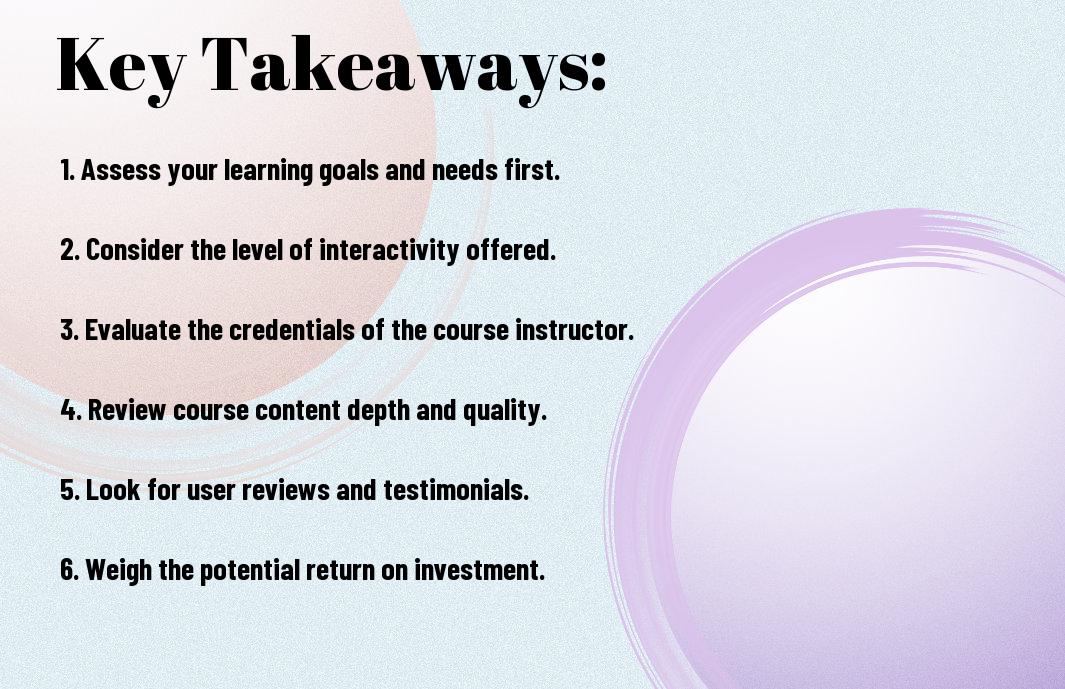As you consider expanding your knowledge and skills, you face a dilemma: whether to enroll in free or paid online courses. Your decision will depend on your goals, budget, and learning style. You must weigh the benefits of free courses, such as accessibility and flexibility, against the potential drawbacks, like limited support and recognition. On the other hand, paid courses offer structured learning and certification, but at a cost. You must evaluate your priorities to make an informed decision that suits your needs.
Key Takeaways:
To make an informed decision between free and paid online courses, consider the following points:
- Understand your learning goals and what you want to achieve from the course, as this will help you determine whether a free or paid option is more suitable.
- Assess the quality of the course content, instructor expertise, and support provided, as paid courses often offer more comprehensive materials and guidance.
- Consider the level of interactivity and engagement you need, as paid courses may offer more opportunities for feedback, discussion, and collaboration.
- Evaluate the certification and credibility of the course, as paid courses are more likely to offer recognized certificates and transferable credits.
- Think about your budget and investment in your education, as paid courses may require a significant financial commitment, but can also lead to greater career benefits and return on investment.

Course Options
Your online learning journey begins with choosing between free and paid courses, each with its own set of benefits and drawbacks that you should consider before making a decision.
Free Online Courses
Above all, free online courses offer an excellent starting point, allowing you to explore various subjects without financial commitment, and you can discover your interests and strengths before investing in a paid course.
Paid Online Courses
For those willing to invest, paid online courses provide structured learning, often with expert instruction and personalized feedback, which can enhance your learning experience and provide you with a more comprehensive understanding of the subject matter.
Due to the varied nature of paid online courses, you will find that they cater to different learning styles, from video lectures to interactive simulations, and you can select the one that best suits your needs, ensuring that you get the most out of your investment and achieve your learning goals.

Learning Objectives
One of the primary considerations when choosing between free and paid online courses is your learning objectives. You need to determine what you want to achieve from the course and whether it aligns with your goals.
Setting Goals
To determine your learning objectives, you must establish what you want to accomplish through the course, and this will help you decide between free and paid options, considering factors such as course quality and support.
Evaluating Priorities
Behind your decision to choose between free and paid courses is your evaluation of priorities, including factors like budget, time commitment, and the level of support you need to achieve your learning objectives.
Due to the varying levels of quality and support offered by free and paid courses, you must carefully evaluate your priorities to make an informed decision that meets your learning needs and budget, ensuring you get the most out of your chosen course.
Course Content
Not all online courses are created equal, and the content is a significant factor in your decision. When evaluating courses, consider what you want to achieve and what topics are covered.
Curriculum Comparison
Comparing curriculums helps you make an informed decision. The following table outlines the key differences:
Free Courses Paid Courses Limited topics Comprehensive coverage Instructor Expertise
An instructor’s expertise can greatly impact your learning experience. You should investigate the instructor’s background and qualifications to ensure they are knowledgeable in the subject area.
Considering the instructor’s expertise, you will want to look for courses taught by industry professionals or experts in the field. This will give you confidence in the quality of the course and the accuracy of the information presented, allowing you to make the most of your time and investment, and ultimately achieve your learning goals.
Support and Resources
For your online learning journey, consider visiting Free Online Courses vs. Paid Courses: Which One is Right? to make an informed decision.
Availability of Assistance
Between the two options, you’ll find that paid courses often provide more direct support from instructors, while free courses may rely on community forums.
Access to Materials
Against the backdrop of varying course formats, you’ll notice that paid courses typically offer more comprehensive materials, including videos, quizzes, and assignments.
Understanding the differences in access to materials will help you decide which type of course suits your learning style, as you consider the value of detailed study guides and interactive content in a paid course versus the potentially more limited resources of a free course, and how these factors align with your personal preferences and goals.
Cost and Value
Unlike other factors, cost is a significant aspect to consider when choosing between free and paid online courses. You can find more information on this topic in Free Courses vs Paid Courses: A Comprehensive Guide to Making the Right Choice, which outlines the pros and cons of each option.
Weighing Expenses
Valuing your money, you should consider the expenses associated with each type of course, including any additional fees or materials required, to make an informed decision that fits your budget.
Assessing Return on Investment
Along with the cost, you need to assess the potential return on investment, considering how the course will benefit your career or personal growth, and whether the benefits outweigh the expenses.
Further, when evaluating the return on investment, you should consider the skills and knowledge you will gain, and how they will impact your life and career, to ensure that you choose a course that provides the best value for your money and time.
Decision Making
Keep in mind that choosing between free and paid online courses depends on your goals and priorities. You should weigh the pros and cons of each option to make an informed decision that suits your needs.
Considering Lifestyle
The key to selecting the right course is to assess your daily routine and available time. You must consider how your lifestyle will accommodate the demands of the course, ensuring you can dedicate sufficient time to learn and complete assignments.
Evaluating Commitment
With a clear understanding of your goals, you can evaluate your commitment to the course. You should ask yourself if you are willing to dedicate the necessary time and effort to complete the course, and if the potential benefits align with your expectations.
Also, as you evaluate your commitment, consider the level of support and resources you will need to succeed. You may want to look into the course’s structure, instructor feedback, and community engagement to determine if it will provide the necessary support to help you stay committed and motivated throughout the course.
Conclusion
With this in mind, you can now make an informed decision about your online course options. You should consider your goals and budget when choosing between free and paid courses. For more insight, visit Explaining the Difference Between Free and Paid Online Courses to help you make the best choice for your needs, and shape your learning journey accordingly, shaping your future prospects. You will then be able to invest your time wisely.
FAQ
Q: What are the key factors to consider when deciding between free and paid online courses?
A: When choosing between free and paid online courses, consider the course content, instructor expertise, and the level of support provided. Free courses may offer a good introduction to a subject, but paid courses often provide more in-depth knowledge, interactive learning materials, and access to instructors. Additionally, think about your learning goals and what you want to achieve from the course. If you need a certificate or credits, a paid course might be a better option. Evaluate the course reviews, duration, and flexibility to ensure it fits your schedule and learning style.
Q: How do I evaluate the quality of a free online course compared to a paid one?
A: To evaluate the quality of a free online course, look for courses offered by reputable institutions or organizations, and check the credentials of the instructors. Read reviews from other learners to get an idea of the course’s strengths and weaknesses. For paid courses, check if the course provider offers a money-back guarantee or a free trial period. Also, consider the production quality of the course materials, such as video and audio quality, and the level of engagement, including discussion forums and assignments. Lastly, check if the course is accredited or recognized by relevant industry bodies, which can be an indicator of its quality and value.
Q: Are paid online courses worth the investment, and how can I ensure I get the most out of them?
A: Paid online courses can be worth the investment if they align with your career goals, provide personalized feedback, and offer ongoing support. To get the most out of a paid course, set clear learning objectives and create a schedule to complete the course materials. Engage with the course community, ask questions, and participate in discussions to enhance your learning experience. Additionally, take advantage of any additional resources, such as one-on-one coaching, mentorship, or career support, that may be included in the course. By being proactive and committed to your learning, you can maximize the value of a paid online course and achieve your desired outcomes.
